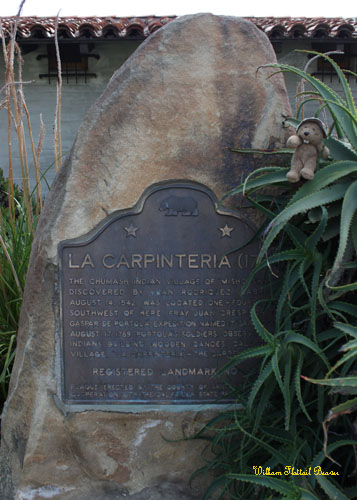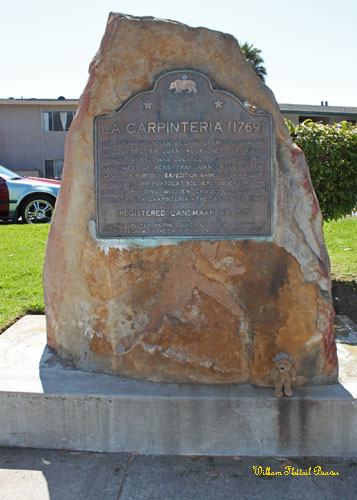 |
| Landmark #535 | Santa Barbara County | Visited: Sept. 4, 2011 | Plaque? YES! 🙂 |
| What is it? | Two plaques commemorating the Chumash village of Mishopshnow, whose canoe builders gave the town of Carpinteria its name! |
| What makes it historical? | THE GUIDE SAYS: The Chumash Indian village of Mishopshnow, discovered by Juan Rodríguez Cabrillo on August 14, 1542, was located one-fourth mile southwest of the monument. Fray Juan Crespí of the Gaspar de Portolá Expedition named it San Roque on August 17, 1769. Portolá’s soldiers, observing the Indians building wooden canoes, called the village La Carpinteria—the Carpenter’s Shop.
OTHER TIDBITS: Mishopshnow means “correspondence,” because this area was such an importance commerce hub among the Chumash and other visiting tribes! The canoes that the tribe built were called “tomols.” |
| How can I Help the Helpers? | HERE’S HOW:
|
| Where is this place? | LISTED DIRECTIONS: First plaque:
Second plaque:
ANNOTATIONS: From Los Angeles: ~84mi (136km) — 1.4hrs |
| When should I go? | Whenever the mood strikes you! |


The two plaques were originally located on Highway 101 near Casitas Pass Road, with one on the northbound side and one on the southbound side. One-fourth mile southwest of there is the Portolá Sycamore, the location of The Carpenter Shop.
The second plaque is at the corner of Concha Loma Drive, and 0.3 miles down Concha Loma Drive in the residential neighborhood is a midden mound of sea shells created by the local Chumash Indians who used this site as their kitchen for thousands of years. The mound is covered with avocado trees, and broken sea shells can be seen on the curb along Concha Loma, which is Spanish for Seashell Mound.